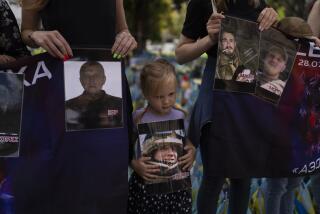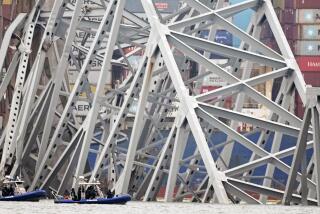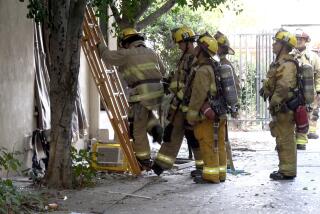Clues in N.Y. Blast Point to a Bomb; Injury Toll Rises : Disaster: Police call World Trade Center explosion a ‘callous criminal act.’ Unsafe conditions hamper investigation. Two people are missing; 1,042 are hurt.
NEW YORK — Police investigators on Saturday called the World Trade Center blast that killed at least five people a “callous criminal act” and officially acknowledged for the first time that it apparently was caused by a bomb.
“There are three factors: the magnitude of the explosion, the fact that a significant amount of heat was generated and the fact that traces of nitrate were found. These strongly indicate there was some sort of explosive device detonated,” New York City Police Commissioner Raymond Kelly said.
And Gov. Mario M. Cuomo, after a tour of the damaged area, bluntly stated: “It looks like a bomb, it smells like a bomb, it probably is a bomb.”
However, more than 24 hours after the blast, which also left at least two missing and 1,042 injured, investigators still were unable to begin their painstaking search for clues in the rubble of the trade center’s devastated parking garage. Unsafe conditions, also delaying the search for more victims, could stymie investigators through the weekend.
“We’ve got concrete floors falling down, walls knocked down, piles of cinder blocks, broken pipes, cable hanging all over, a lot of water--it’s just not safe down there yet,” said Charles Maikish, director of the Port Authority, which operates the building complex. He predicted that work to shore up and make the area safe could take two days or more.
So far, investigators said they have made only limited inspections of the scene, extracting samples of rubble for laboratory testing to confirm the presence of nitrate. Signs of scorching caused by intense heat also were visible. But explosives experts have not been able to sift the debris for fragments of a bomb or clues to the vehicle believed to have contained it.
“We can’t get into the immediate area because of the instability of the immediate area,” said Kelly. Meanwhile, the Port Authority ordered heightened security at all New York area airports, the first such move since even more stringent precautions were ordered during the 1991 Persian Gulf War. Security also was stepped up at the Pentagon and at various unidentified American embassies overseas, according to federal sources.
In Washington, President Clinton vowed in a radio broadcast Saturday to “find out who was involved and why this happened.” He said that the “full measure of federal law enforcement resources will be brought to bear on this investigation.”
Federal intelligence officials, meanwhile, were trying to determine whether the explosion was linked to any foreign government or international terrorist group. On Friday, about an hour after the explosion, a caller identifying himself as a member of the Serbian National Front claimed responsibility and provided what authorities regarded as surprisingly detailed information about the source of the explosion.
But on Saturday, a U.S. counterterrorism official expressed skepticism that Serbian sympathizers might have been responsible, noting that none of the warring Yugoslavian factions had previously used car bombs. The source said it is not uncommon for people from rival groups to call and try to place blame on their enemies.
In Belgrade, Bosnian Serb leader Radovan Karadzic scoffed at speculation linking Serb extremists to a possible bombing, telling Reuters Television: “It would be an idiotic mind to make that conclusion . . . . We don’t need any liberation front. We are liberating ourselves.”
Karadzic spoke at the airport en route to New York, where he will participate in United Nations-sponsored peace talks on the Bosnian civil war.
Several private U.S. terrorist specialists, however, including Bruce Hoffman of the RAND Corp. in Santa Monica, said suspicion would fall inevitably on groups tied to the Yugoslav crisis. He noted that the bombing came “at a time when the United States is fundamentally changing its involvement in the Bosnian crisis and in a manner that is not universally welcomed on the ground.”
By Saturday morning, investigators had received 19 calls, some of them “rather disjointed,” claiming responsibility for the explosion, according to Kelly. The police commissioner and other law enforcement officers also denied earlier published and broadcast reports that a caller had warned of a bombing shortly before the explosion.
“To my knowledge, we received no advance warning,” said James Fox, head of the New York FBI office.
In fact, officials noted Saturday that the explosion lacked some of the typical signs of a well-planned and coordinated terrorist attack. Not only was there no warning, but there was no specific target to indicate a clear motive. About 350 businesses employing more than 50,000 people operate out of the seven-building complex--none apparently linked to any international controversy.
Of course, it also is possible that no warning was issued because a bomb may have gone off prematurely. “We don’t know if they’re going to find parts of the bomber himself down there,” said one Port Authority official.
Some experts cautioned that it was too early to attribute the explosion to terrorists of any stripe. In a television appearance Saturday, L. Paul Bremer, former U.S. ambassador for counterterrorism, noted that it could have been the work of “a demented person” or someone with a grudge.
And Hoffman of RAND said that despite the power of the suspected bomb, its detonation appeared to be “calculated for maximum publicity . . . not aimed primarily at killing, or it would have been placed somewhere else . . . . This one was calculated to make a lot of noise and damage and destruction.”
Hoffman said that whoever did it wanted “to cause as much disruption as possible . . . and a lot of newsworthy and emotional publicity.”
On Saturday, city and state officials also were expressing wonder at the relatively small loss of life. Of the five confirmed deaths, four were Port Authority employees working in the vicinity of the blast. The two people listed as missing also are Port Authority employees.
According to police, those who died as a result of the explosion were John Digiovanni, 45, of Valley Stream, N.Y.; Robert Kirkpatrick, 61, of Suffern, N.Y.; Steve Knapp, 48, of New York City; William Macko, no age available, of Bayonne, N.J., and Monica Smith, 34, of Seaford, N.Y.
Of the 1,042 injuries--most of them related to smoke inhalation--only 15 were hurt by the force of the blast itself, officials said.
Because an emergency generator in a sub-basement shorted out after it was flooded, fans that could have cleared smoke from the building did not operate, Port Authority officials said. Thousands fled through stairwells in the 110-story tower complex, but the stairs were dark because emergency escape lights did not have a battery-powered backup, the agency said.
Cuomo, while expressing sympathy to the families of the victims, noted that only five fatalities occurred in a building complex occupied by more than 50,000 and concluded: “I say, thank God.”
Destruction Beneath the Towers
* World Trade Center: Although both towers were affected and evacuated, tower 1 was most affected by the smoke.
* New York Vista Hotel and B-1 level: The Vista Hotel main floor was damaged as the explosion ripped through the B-1 level below.
* B-2 level: Source of explosion. Four of five people killed were found on this level. Rescuers believe that two people still missing are on this level.
* B-3 and B-4 levels: The force of the explosion collapsed the floors and walls on the B-3 and B-4 levels, where a commuter train entrance and platform are located.
* B-5 and B-6 levels: Damage from the explosion reached the B-6 level, where flooding disabled a backup generator.
Source: AP
More to Read
Sign up for Essential California
The most important California stories and recommendations in your inbox every morning.
You may occasionally receive promotional content from the Los Angeles Times.










